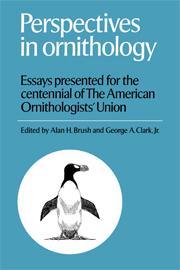 Perspectives in Ornithology
Perspectives in Ornithology Book contents
- Frontmatter
- Contents
- List of contributors
- Preface
- Introduction
- 1 Captive birds and conservation
- 2 Research collections in ornithology – a reaffirmation
- 3 On the study of avian mating systems
- 4 Cooperative breeding strategies among birds
- 5 Ecological energetics: what are the questions?
- 6 Perspectives in optimal foraging
- 7 Biochemical studies of microevolutionary processes
- 8 Organization of the avian genome
- 9 The origin and early radiation of birds
- 10 Avian community ecology: an iconoclastic view
- 11 Biogeography: the unification and maturation of a science
- 12 Bird song learning: theme and variations
- 13 Bird navigation
- Index
8 - Organization of the avian genome
Published online by Cambridge University Press: 04 August 2010
- Frontmatter
- Contents
- List of contributors
- Preface
- Introduction
- 1 Captive birds and conservation
- 2 Research collections in ornithology – a reaffirmation
- 3 On the study of avian mating systems
- 4 Cooperative breeding strategies among birds
- 5 Ecological energetics: what are the questions?
- 6 Perspectives in optimal foraging
- 7 Biochemical studies of microevolutionary processes
- 8 Organization of the avian genome
- 9 The origin and early radiation of birds
- 10 Avian community ecology: an iconoclastic view
- 11 Biogeography: the unification and maturation of a science
- 12 Bird song learning: theme and variations
- 13 Bird navigation
- Index
Summary
The term “genome” has been used in its most restrictive context by eukaryotic geneticists to refer to the genetic component of a complete, or haploid, set of chromosomes of an individual. Alternatively, discussions of the genome might involve considerations of the amount of DNA per haploid nucleus or the morphology and number of an entire (diploid) complement of chromosomes. Furthermore, the genome might be discussed in terms of how DNA sequences are arranged in relation to one another and how individual genes or groups of genes are structured and how they function. The broader use of the term “genome” will be emphasized here, because it is the purpose of this review to interrelate the several aspects of the avian genome as we now understand them in terms of their structure and apparent function.
With the exception of a number of domesticated species of economic or special interest, studies directed at an understanding of the formal genetics of birds have not been widespread. A tremendous amount of information exists, however, concerning the distribution, morphology, reproductive biology, and behavior of wild birds. Thus, it seems that birds would be excellent models for study at genetic and molecular levels. Recent innovations in technique, particularly those directed at an understanding of the organization of the genome, have resulted in significant progress.
Genome size
Amounts of DNA in nuclei of cells have traditionally been determined by measuring the uptake of the DNA-specific Feulgen stain through microdensitometry.
- Type
- Chapter
- Information
- Perspectives in OrnithologyEssays Presented for the Centennial of the American Ornitholgists' Union, pp. 271 - 290Publisher: Cambridge University PressPrint publication year: 1983
- 6
- Cited by


